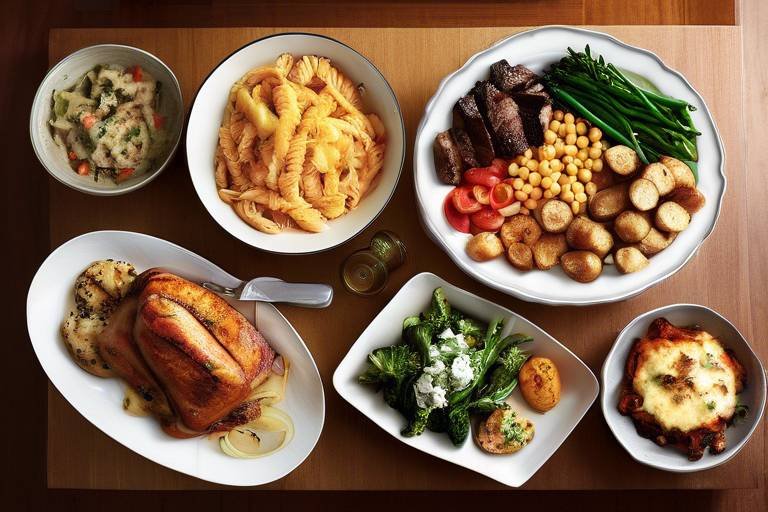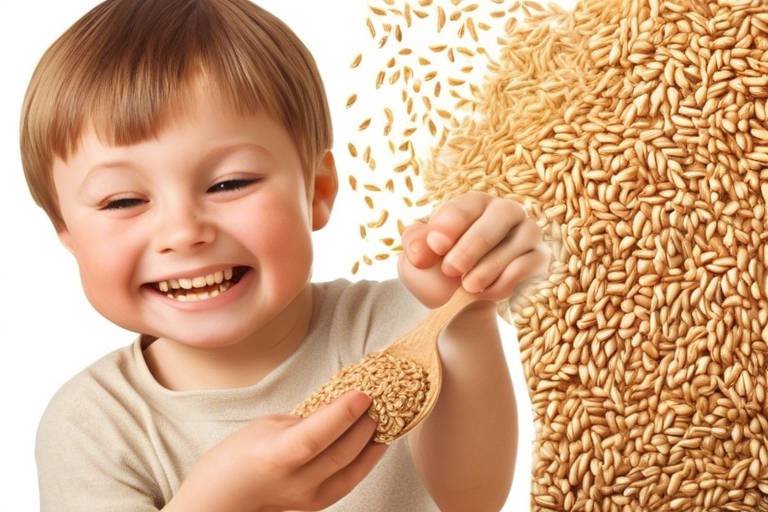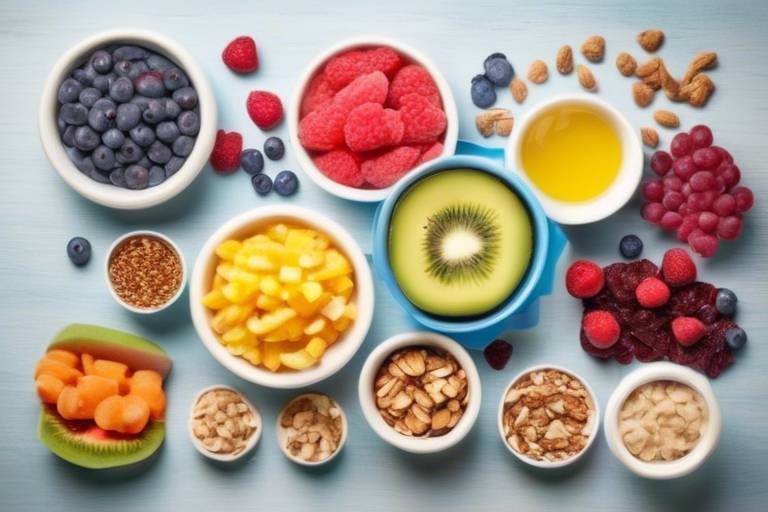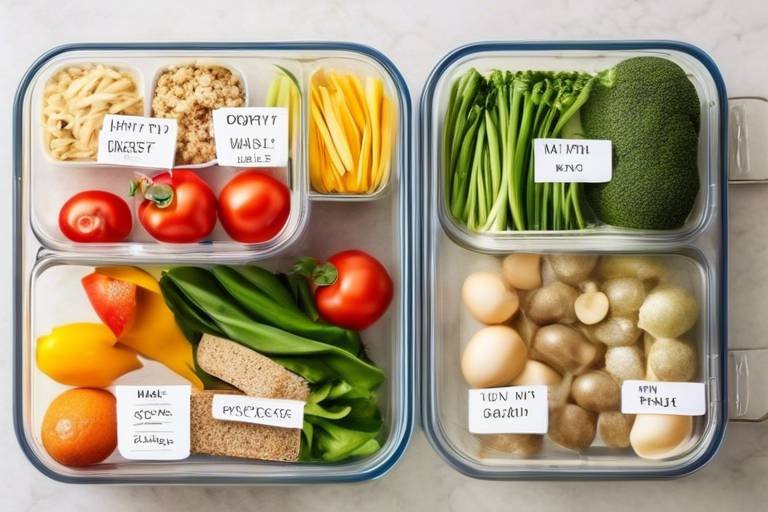A Guide to Healthy Grains for Your Family's Meals
In today's fast-paced world, it's easy to overlook the importance of healthy grains in our diets. However, incorporating these nutritious powerhouses into your family's meals can lead to a plethora of health benefits. Not only do whole grains provide essential nutrients, but they also serve as a delicious foundation for a variety of dishes that even the pickiest eaters will enjoy. So, buckle up as we explore the world of healthy grains, from what they are, to how you can prepare them, and the incredible benefits they bring to your table!
Whole grains are the unrefined seeds of cereal crops, which include the bran, germ, and endosperm. Unlike refined grains that have been stripped of their nutritious components, whole grains retain all parts of the grain, making them a nutritional powerhouse. They are rich in fiber, vitamins, and minerals, which are vital for maintaining optimal health. By choosing whole grains over their refined counterparts, you are not just making a healthier choice; you are also enhancing your family's meals with depth and flavor. Imagine biting into a warm bowl of oatmeal or a hearty slice of whole grain bread – it’s not just food; it’s a nourishing experience!
When it comes to healthy grains, the options are vast and varied. Here are some popular choices that you can easily incorporate into your family's meals:
- Quinoa: Often hailed as a superfood, quinoa is packed with protein and essential amino acids.
- Brown Rice: A versatile staple that can be used in countless dishes.
- Barley: Known for its chewy texture and nutty flavor, barley is great in soups and salads.
- Farro: An ancient grain that adds a delightful chewiness and rich flavor to any meal.
Each of these grains brings unique benefits to the table, allowing you to experiment and create diverse meals that cater to your family's tastes and nutritional needs.
Quinoa is often celebrated as a superfood, and for good reason! This tiny grain is a complete protein, meaning it contains all nine essential amino acids that our bodies need. It’s also gluten-free, making it an excellent choice for those with dietary restrictions. Incorporating quinoa into your family's meals is not only easy but also incredibly delicious. Picture a vibrant quinoa salad brimming with colorful veggies and a zesty dressing – it’s a feast for both the eyes and the palate!
Mastering the art of cooking quinoa can elevate its flavor and texture, making it a delightful addition to your meals. Here’s how to achieve perfect quinoa every time:
1. Rinse the quinoa under cold water to remove its natural coating, called saponin, which can taste bitter. 2. Use a ratio of 2 cups of water or broth to 1 cup of quinoa. 3. Bring the liquid to a boil, then reduce the heat, cover, and simmer for about 15 minutes. 4. Once the quinoa is fluffy and the water is absorbed, let it sit for 5 minutes before fluffing with a fork.
With these simple steps, you’ll have perfectly cooked quinoa that’s ready to be added to salads, stir-fries, or served as a side dish.
Now that you know how to cook quinoa, let’s explore some family-friendly recipes that will make everyone excited to eat healthy:
- Quinoa and Black Bean Tacos: A fun twist on taco night with protein-packed quinoa and black beans.
- Quinoa Salad with Roasted Vegetables: A colorful dish that’s as nutritious as it is tasty.
- Quinoa Breakfast Bowl: Start the day right with a warm bowl topped with fruits and nuts.
These recipes not only highlight quinoa’s versatility but also ensure that your family enjoys wholesome meals without sacrificing flavor!
Brown rice is a staple in many households and for good reason. It’s a whole grain that is packed with fiber, which helps keep you feeling full and satisfied. Plus, its nutty flavor and chewy texture make it a delightful base for a variety of dishes. From stir-fries to casseroles, brown rice can easily adapt to whatever flavors you throw its way. Think of it as a blank canvas waiting for you to add your culinary masterpiece!
Eating whole grains is not just a trend; it's a lifestyle choice that comes with a host of health benefits. Research shows that incorporating whole grains into your diet can lead to improved digestion, better heart health, and effective weight management. It’s like giving your body a gift that keeps on giving!
The fiber found in whole grains is essential for maintaining digestive health. It promotes regularity and helps prevent gastrointestinal issues that can be uncomfortable and disruptive. By including fiber-rich grains in your family’s meals, you’re not just feeding their bodies; you’re also supporting their overall well-being.
Did you know that incorporating whole grains into your meals can lower cholesterol levels and reduce the risk of heart disease? It’s true! The nutrients found in whole grains work together to promote cardiovascular health, making them a vital part of a heart-healthy diet. Think of whole grains as your heart’s best friend!
As we wrap up our guide to healthy grains, you might have some questions. Here are a few common queries:
- What is the difference between whole grains and refined grains? Whole grains retain all parts of the grain, while refined grains have been processed to remove the bran and germ, stripping away vital nutrients.
- How can I incorporate more whole grains into my diet? Start by swapping white rice for brown rice, or try adding quinoa or barley to soups and salads.
- Are whole grains suitable for children? Absolutely! Whole grains are packed with nutrients that are essential for growing bodies.
By understanding and embracing healthy grains, you can transform your family's meals into a delicious and nutritious experience. So, why not start today? Your body will thank you!

Understanding Whole Grains
Whole grains are the unsung heroes of a balanced diet, often overshadowed by their refined counterparts. But what exactly are whole grains? In simple terms, they include all parts of the grain kernel: the bran, germ, and endosperm. This means they retain all their natural nutrients, unlike refined grains, which have been stripped of many beneficial components during processing. When you choose whole grains, you're not just making a healthier choice; you're also treating your body to a powerhouse of fiber, vitamins, and minerals.
One of the most significant advantages of whole grains is their high fiber content. This fiber plays a crucial role in digestion, helping to keep things moving smoothly through your system. Have you ever felt sluggish after a heavy meal? That could be because of a lack of fiber! Whole grains can help prevent that uncomfortable feeling by promoting regularity and reducing the risk of digestive issues. In fact, studies suggest that a diet rich in fiber can lower the risk of developing conditions like diverticulitis and constipation.
Moreover, whole grains are a fantastic source of essential vitamins and minerals. For instance, they are rich in B vitamins, which are vital for energy production, and minerals like iron and magnesium, which support various bodily functions. By incorporating whole grains into your family's meals, you're not only enhancing flavor but also boosting overall health. Think of whole grains as the foundation of a well-balanced meal, providing the nutrients that fuel your family’s daily activities.
So, how do you identify whole grains? It's easier than you might think! When shopping for grains, look for products that list "whole grain" as the first ingredient on the label. Common examples include:
- Whole wheat - Great for bread and pasta
- Brown rice - A versatile side dish
- Oats - Perfect for a hearty breakfast
- Barley - Fantastic in soups and salads
- Quinoa - A protein-packed superfood
Incorporating whole grains into your diet isn't just beneficial; it's also a delicious journey of flavors and textures. From nutty brown rice to fluffy quinoa, there's a whole world of grains waiting to be explored. So next time you're planning your family's meals, remember that choosing whole grains can make a significant difference in their health and well-being. Embrace the goodness of whole grains and watch as your family's meals transform into nourishing feasts!

Popular Types of Healthy Grains
When it comes to healthy eating, grains often take center stage, and for good reason! They are not just a side dish; they can be the star of your meals. Incorporating a variety of healthy grains into your family's diet can add a delightful twist to your meals while boosting nutrition. Let's dive into some of the most popular healthy grains that can transform your cooking and promote well-being.
First up is quinoa, often referred to as a superfood. This tiny grain packs a mighty punch! It's gluten-free, high in protein, and contains all nine essential amino acids, making it a complete protein source. Quinoa is incredibly versatile and can be used in salads, soups, or even as a base for a hearty bowl. Just imagine a colorful quinoa salad with fresh veggies and a zesty dressing—yum!
Next on our list is brown rice. This whole grain is a staple in many households and for a good reason. Brown rice is not only filling but also rich in fiber, which is essential for digestive health. You can use it as a side dish, in stir-fries, or as a base for grain bowls. Plus, it has a lovely nutty flavor that can elevate any meal. Just picture a warm bowl of brown rice topped with your favorite protein and veggies—comfort food at its best!
Another grain worth mentioning is barley. Often overlooked, barley is a fantastic addition to soups and stews, providing a chewy texture that can make your dishes more satisfying. It's also rich in beta-glucans, which are known to help lower cholesterol levels. Think of barley as the underdog of grains, quietly working its magic while you enjoy a hearty bowl of soup on a chilly day.
Lastly, we can't forget about farro, an ancient grain that has made a comeback in recent years. Farro is packed with nutrients and has a delightful chewy texture that makes it perfect for salads or as a side dish. Its nutty flavor complements a variety of ingredients, making it a fantastic choice for experimenting in the kitchen. Imagine a warm farro salad with roasted vegetables and a sprinkle of feta cheese—delicious!
To summarize, here are the key healthy grains discussed:
- Quinoa: Complete protein, gluten-free, versatile.
- Brown Rice: Nutty flavor, rich in fiber, filling.
- Barley: Chewy texture, great for soups, helps lower cholesterol.
- Farro: Ancient grain, nutritious, perfect for salads.
Incorporating these healthy grains into your meals not only enhances flavor and texture but also brings a wealth of nutrients to your family's diet. So, why not experiment with these grains? Your taste buds and your body will thank you!

Quinoa: A Superfood
Quinoa, often referred to as a superfood, has gained immense popularity in recent years, and for good reason! This tiny seed packs a powerful punch in terms of nutrition. Unlike many grains, quinoa is a complete protein, meaning it contains all nine essential amino acids that our bodies cannot produce on their own. This makes it an excellent choice for vegetarians and vegans looking to boost their protein intake without relying on animal products.
But quinoa isn't just about protein; it's also loaded with other vital nutrients. It is rich in fiber, which aids in digestion and helps keep you feeling full longer. Additionally, quinoa is a fantastic source of magnesium, iron, and vitamins B and E. These nutrients contribute to overall health, supporting everything from energy levels to skin health. So, if you’re looking to enhance your family’s meals with something not only tasty but also highly nutritious, quinoa should be at the top of your list!
Incorporating quinoa into your family's meals is easier than you might think. It can be used in a variety of dishes, from salads to soups, and even as a side dish. Its mild, nutty flavor makes it a versatile ingredient that pairs well with many different foods. For instance, you can add cooked quinoa to:
- Salads for added texture and nutrition
- Soups to make them heartier
- Stir-fries for a protein boost
- Breakfast bowls, mixed with fruits and nuts
One of the best things about quinoa is how quickly it cooks. In just about 15 minutes, you can have a fluffy, delicious grain ready to serve. This is particularly beneficial for busy families who want to prepare healthy meals without spending hours in the kitchen. Plus, quinoa is gluten-free, making it a great option for those with gluten sensitivities or celiac disease.
As you explore the world of quinoa, don’t forget to experiment with different varieties! While the most common type is white quinoa, you can also find red and black quinoa, each offering a unique flavor and texture. Red quinoa tends to be a bit nuttier and chewier, while black quinoa has a slightly sweeter taste. Mixing different colors not only enhances the visual appeal of your dishes but also adds a variety of nutrients.
In summary, quinoa is more than just a trendy ingredient; it’s a nutritional powerhouse that can elevate your family's meals. By incorporating this superfood into your diet, you're not only feeding your family delicious meals but also nourishing their bodies with essential nutrients. So, why not give quinoa a try? Your taste buds and your health will thank you!
1. Is quinoa a grain or a seed?
Quinoa is technically a seed, but it is often classified as a whole grain due to its cooking and nutritional properties.
2. How do you cook quinoa?
To cook quinoa, rinse it under cold water, then combine it with water in a pot (typically a 2:1 ratio of water to quinoa). Bring it to a boil, then reduce the heat, cover, and simmer for about 15 minutes or until the water is absorbed.
3. Can quinoa be eaten raw?
While quinoa can be sprouted and eaten raw, it is typically cooked to enhance its flavor and digestibility.
4. How can I store cooked quinoa?
Cooked quinoa can be stored in an airtight container in the refrigerator for up to a week or frozen for longer storage.

Cooking Techniques for Quinoa
Cooking quinoa may seem daunting at first, but once you master a few simple techniques, you'll find it's as easy as boiling water! First things first, rinsing your quinoa is crucial. This step removes the natural coating called saponin, which can give quinoa a bitter taste. Just place the quinoa in a fine-mesh strainer and rinse it under cold water for about 30 seconds. Trust me, this little step makes a world of difference!
Next, let's talk about the perfect water-to-quinoa ratio. A good rule of thumb is to use two cups of water for every cup of quinoa. This ratio ensures that the quinoa cooks evenly and absorbs just the right amount of moisture. Bring the water to a boil, then add the rinsed quinoa. Once it’s boiling again, reduce the heat to low, cover it, and let it simmer for about 15 minutes. It’s like a mini magic show in your kitchen as the quinoa transforms from tiny seeds into fluffy grains!
After the cooking time is up, it’s important to let the quinoa rest for about five minutes. This allows the grains to absorb any remaining water and become even fluffier. Once the resting time is over, use a fork to fluff the quinoa gently. This step not only enhances its texture but also makes it look super inviting on the plate.
Now that you’ve got the basics down, let’s explore a few cooking variations to elevate your quinoa game:
- Broth instead of water: For an extra flavor boost, try cooking your quinoa in vegetable or chicken broth instead of plain water. This simple swap adds depth and richness to your dish.
- Herbs and spices: Adding herbs like thyme or spices such as cumin during cooking can infuse your quinoa with delightful flavors. Experiment with different combinations to find your family’s favorite!
- Toasting: For a nutty flavor, consider toasting your quinoa before cooking. Simply sauté it in a dry skillet for a few minutes until it turns golden brown, then proceed with the cooking process.
Quinoa is incredibly versatile, and these cooking techniques will help you create a variety of delicious, nutritious meals. Whether you’re making a hearty salad, a warm pilaf, or a comforting bowl of quinoa porridge, mastering these techniques will make you a quinoa pro in no time!
Q: Can I cook quinoa in a rice cooker?
A: Absolutely! Cooking quinoa in a rice cooker is a convenient option. Just use the same water-to-quinoa ratio and follow your rice cooker's instructions. It’s a hands-off way to achieve perfectly cooked quinoa!
Q: How do I store leftover quinoa?
A: Store leftover quinoa in an airtight container in the refrigerator. It should last for about 3 to 5 days. You can also freeze it for longer storage—just make sure to let it cool completely before placing it in a freezer-safe bag!
Q: Is quinoa gluten-free?
A: Yes! Quinoa is naturally gluten-free, making it an excellent choice for those with gluten sensitivities or celiac disease. It’s a nutritious alternative to traditional grains.

Quinoa Recipes for Families
When it comes to incorporating quinoa into your family's meals, the possibilities are as endless as your imagination! Quinoa is not only a nutritional powerhouse, but it also serves as a blank canvas that can take on a variety of flavors and textures. Here are some delightful quinoa recipes that are sure to please even the pickiest eaters in your family.
One of the easiest and most versatile recipes is the Quinoa and Vegetable Stir-Fry. Start by cooking one cup of quinoa according to package instructions. While it's cooking, sauté your favorite vegetables—think bell peppers, broccoli, and carrots—in a splash of olive oil. Once the veggies are tender, mix in the cooked quinoa and season with soy sauce or teriyaki sauce. This dish is not only colorful but also packed with vitamins and minerals, making it a fun way to get your kids to eat their greens!
If your family enjoys a bit of spice, try making a Spicy Quinoa Chili. Begin by cooking quinoa as usual, then in a large pot, sauté onions, garlic, and bell peppers until fragrant. Add canned tomatoes, kidney beans, corn, and your favorite chili spices. Stir in the cooked quinoa and let it simmer for about 20 minutes. Serve this hearty chili with a dollop of sour cream or avocado on top, and watch your family devour it!
For a refreshing twist, consider a Quinoa Salad. Combine cooked and cooled quinoa with diced cucumbers, cherry tomatoes, red onion, and parsley. Drizzle with olive oil and lemon juice, then season with salt and pepper. This salad is not only nutritious but also perfect for summer picnics or as a side dish during family barbecues. You can even let your kids help by choosing their favorite veggies to add!
Finally, don’t forget about breakfast! A Quinoa Breakfast Bowl can be a game-changer. Cook quinoa and mix it with almond milk, honey, and a sprinkle of cinnamon. Top with fresh fruits like bananas, berries, or nuts. This warm, comforting bowl is a fantastic way to start the day, providing energy and satisfaction that lasts until lunchtime.
By exploring these recipes, you can easily introduce quinoa into your family's diet in a way that's both enjoyable and nutritious. Remember, the key is to keep it fun and engaging. Get your kids involved in the cooking process—let them choose ingredients or help with simple tasks. This not only teaches them valuable cooking skills but also encourages them to try new foods!
1. Can quinoa be eaten daily?
Yes, quinoa is a healthy grain that can be included in your daily diet. It provides essential nutrients, including protein, fiber, and various vitamins and minerals.
2. How do I store cooked quinoa?
Cooked quinoa can be stored in an airtight container in the refrigerator for about 3 to 5 days. You can also freeze it for longer storage, which makes meal prep even easier!
3. Is quinoa gluten-free?
Absolutely! Quinoa is naturally gluten-free, making it an excellent option for those with gluten sensitivities or celiac disease.
4. How can I make quinoa more flavorful?
Cooking quinoa in vegetable or chicken broth instead of water can enhance its flavor. Additionally, adding spices, herbs, or mixing it with sautéed vegetables can make it even tastier!

Brown Rice Versatility
Brown rice is often regarded as a pantry staple, but its versatility goes far beyond just being a side dish. Unlike its white counterpart, brown rice retains its bran and germ layers, making it not only more nutritious but also a fantastic canvas for a variety of meals. Imagine brown rice as the blank slate of your culinary creations, ready to absorb flavors and complement a multitude of ingredients. It’s rich in fiber, vitamins, and minerals, which means it doesn’t just fill you up; it fuels your body with essential nutrients.
One of the best things about brown rice is its ability to adapt to different cuisines. Whether you’re whipping up a hearty stir-fry, a comforting casserole, or a refreshing salad, brown rice can seamlessly fit into your meal plans. Its nutty flavor and chewy texture add depth to dishes, making every bite satisfying. Plus, it’s an excellent choice for those looking to maintain a healthy lifestyle, as it helps regulate blood sugar levels and keeps you feeling full longer.
To inspire your culinary adventures, consider these popular ways to incorporate brown rice into your meals:
- Stir-Fries: Toss cooked brown rice with your favorite vegetables and protein for a quick, nutritious meal.
- Salads: Use brown rice as a base for salads, mixing in fresh veggies, beans, and a zesty dressing.
- Casseroles: Substitute white rice with brown rice in casseroles for added texture and flavor.
- Sushi: Try using brown rice for sushi rolls; it adds a unique twist to this traditional dish.
When it comes to cooking brown rice, patience is key. It typically takes longer to cook than white rice, but the result is well worth the wait. The process involves rinsing the rice to remove excess starch, which helps achieve a fluffier texture. Then, simmer it in water or broth for about 45 minutes, allowing it to absorb all the delicious flavors. The end result is a nutty, chewy grain that can elevate any dish.
For those busy weeknights, consider batch-cooking brown rice in advance. Store cooked rice in the refrigerator for up to a week, or freeze portions for longer storage. This way, you can quickly add it to meals without compromising on nutrition or flavor. The versatility of brown rice makes it a go-to ingredient for meal prep, ensuring that healthy options are always within reach.
In summary, brown rice is more than just a side dish; it’s a versatile ingredient that can enhance a wide range of meals. Its nutritional benefits, combined with its ability to adapt to various cuisines, make it a fantastic choice for families looking to eat healthier. So, the next time you’re planning your meals, don’t overlook the potential of brown rice. Embrace its versatility and let it shine in your kitchen!
1. How long does brown rice take to cook?
Brown rice typically takes about 45 minutes to cook, depending on the specific variety and cooking method.
2. Can I substitute brown rice for white rice in recipes?
Yes, you can substitute brown rice for white rice in most recipes. Just keep in mind that you may need to adjust the cooking time and liquid ratios.
3. Is brown rice healthier than white rice?
Yes, brown rice is generally considered healthier because it contains more fiber, vitamins, and minerals due to the retention of the bran and germ layers.
4. How should I store cooked brown rice?
Store cooked brown rice in an airtight container in the refrigerator for up to a week or freeze it for longer storage.

Health Benefits of Eating Whole Grains
When it comes to nourishing our bodies, whole grains play a pivotal role that often goes unnoticed. These grains are not just a side dish; they are nutritional powerhouses packed with essential vitamins, minerals, and fiber. By making the switch from refined grains to whole grains, you're not only enhancing your meals but also investing in your family's long-term health. But what exactly are the benefits of incorporating these wholesome foods into your diet? Let's dive deeper!
First and foremost, one of the standout benefits of whole grains is their ability to improve digestive health. Whole grains are rich in dietary fiber, which is crucial for maintaining a healthy digestive system. Fiber helps to bulk up your stool, making it easier to pass and reducing the risk of constipation. In fact, studies have shown that a diet high in fiber can help prevent gastrointestinal issues such as diverticulitis and hemorrhoids. So, if you want to keep your gut happy, whole grains should be a staple on your dinner table!
Additionally, whole grains are linked to heart health. Consuming whole grains can help lower cholesterol levels, thereby reducing the risk of heart disease. The fiber found in whole grains helps to remove excess cholesterol from the body, while their high antioxidant content combats inflammation, a key player in heart disease. According to research, individuals who regularly consume whole grains have a significantly lower risk of developing cardiovascular diseases compared to those who stick to refined grains. Isn’t it amazing how something as simple as a grain can have such a profound impact on our heart health?
Moreover, whole grains can assist with weight management. The fiber in these grains not only aids digestion but also promotes a feeling of fullness. This means that when you incorporate whole grains into your meals, you’re less likely to overeat. Plus, whole grains have a lower glycemic index than refined grains, which helps to stabilize blood sugar levels. This is particularly beneficial for those looking to maintain or lose weight, as it reduces cravings and keeps your energy levels steady throughout the day.
| Health Benefits | How Whole Grains Help |
|---|---|
| Digestive Health | High in fiber, promotes regularity, prevents constipation |
| Heart Health | Lowers cholesterol, reduces risk of heart disease |
| Weight Management | Promotes fullness, stabilizes blood sugar levels |
Incorporating whole grains into your family's meals doesn't have to be a chore. Think of it as an exciting adventure! Whether you’re swapping white rice for brown rice or adding a scoop of quinoa to your salads, the possibilities are endless. You can even experiment with different grains like farro or barley to keep your meals fresh and exciting. So why not take the plunge and explore the world of whole grains? Your body will thank you!
- What are whole grains? Whole grains are grains that contain all parts of the grain kernel – the bran, germ, and endosperm. Examples include brown rice, quinoa, barley, and whole wheat.
- How can I incorporate more whole grains into my diet? Start by replacing refined grains with whole grains in your meals. Use brown rice instead of white rice, add oats to your breakfast, or try whole grain pasta.
- Are whole grains suitable for everyone? Yes, whole grains are generally safe for most people. However, those with certain digestive disorders may need to consult a healthcare provider.

Whole Grains and Digestive Health
When it comes to maintaining a healthy gut, whole grains are your best friends! These nutritional powerhouses are packed with fiber, which plays a crucial role in supporting digestive health. Unlike refined grains, which often lose their fiber content during processing, whole grains retain their natural goodness, making them a fantastic choice for anyone looking to improve their digestion.
Fiber is essential for promoting regular bowel movements and preventing constipation. It acts like a broom, sweeping through your digestive tract and helping to keep everything moving smoothly. But that's not all—fiber also feeds the beneficial bacteria in your gut, promoting a healthy microbiome. A balanced microbiome is key to overall health, as it can influence everything from your immune system to your mood!
Here are some of the ways whole grains contribute to digestive health:
- Increased Regularity: The soluble and insoluble fibers found in whole grains help bulk up stool and facilitate easier passage through the intestines.
- Reduced Risk of Digestive Disorders: A diet rich in whole grains may lower the risk of developing digestive disorders such as diverticulitis and colorectal cancer.
- Enhanced Nutrient Absorption: Whole grains can aid in the absorption of nutrients by promoting a healthy gut environment, ensuring your body gets the most out of the food you consume.
Incorporating whole grains into your family's meals can be as simple as swapping out white rice for brown rice or choosing whole grain bread over white bread. The key is to make gradual changes that everyone can adapt to. Start with breakfast—try whole grain oatmeal topped with fresh fruit, or opt for whole grain pancakes on the weekends. By making these small adjustments, you can significantly enhance your family's digestive health.
It's important to note that when introducing more fiber into your diet, you should do so gradually. This allows your digestive system to adjust without causing discomfort. Pairing whole grains with plenty of water can also help ease the transition and maximize their benefits. So, why not take the plunge and start incorporating more whole grains into your meals? Your gut will thank you!
1. What are whole grains?
Whole grains are grains that contain all parts of the grain kernel: the bran, germ, and endosperm. Examples include brown rice, quinoa, barley, and whole wheat.
2. How can I incorporate whole grains into my diet?
You can easily add whole grains to your meals by choosing whole grain versions of bread, pasta, and rice, or by including grains like quinoa and barley in salads and soups.
3. Are whole grains suitable for everyone?
Yes, whole grains are generally beneficial for most people. However, those with specific digestive issues or gluten sensitivities should consult a healthcare provider for personalized advice.
4. How much fiber should I consume daily?
The recommended daily fiber intake is about 25 grams for women and 38 grams for men. Including whole grains in your diet can help you meet these goals.

Whole Grains for Heart Health
When it comes to maintaining a healthy heart, the food we eat plays a crucial role. Whole grains are not just a trendy health fad; they are the unsung heroes of a heart-healthy diet. These grains, which include options like brown rice, quinoa, and oats, are packed with essential nutrients that can help lower cholesterol levels and reduce the risk of heart disease. But how exactly do they work their magic? Let’s take a closer look!
Firstly, whole grains are rich in fiber, a nutrient that plays a significant role in heart health. Fiber helps to lower LDL cholesterol, often referred to as "bad" cholesterol. By including fiber-rich foods in your diet, you can help keep your cholesterol levels in check, which is vital for preventing heart disease. In fact, studies have shown that individuals who consume a diet high in whole grains have a significantly lower risk of developing cardiovascular issues.
Moreover, whole grains are loaded with antioxidants and phytochemicals, which can reduce inflammation in the body. Chronic inflammation is a silent enemy that can lead to various heart-related problems. By incorporating whole grains into your meals, you’re not just filling your plate; you’re also arming your body with powerful nutrients that fight inflammation and promote overall heart health.
Another benefit of whole grains is their ability to help with weight management. Maintaining a healthy weight is crucial for heart health, and whole grains can assist in this area as well. They are more filling than refined grains, meaning you’re likely to feel satisfied longer after a meal. This can help you avoid overeating and snacking on unhealthy options. For families, this means that incorporating whole grains can lead to healthier eating habits for everyone!
To put things into perspective, let’s look at a quick comparison of whole grains versus refined grains:
| Aspect | Whole Grains | Refined Grains |
|---|---|---|
| Nutritional Content | High in fiber, vitamins, and minerals | Low in nutrients, often enriched |
| Cholesterol Impact | Helps lower LDL cholesterol | May contribute to higher cholesterol levels |
| Weight Management | More filling, helps control appetite | Less filling, may lead to overeating |
In conclusion, incorporating whole grains into your family's diet is a simple yet effective way to enhance heart health. Whether you choose to serve a hearty bowl of oatmeal for breakfast or a side of quinoa with dinner, the benefits are undeniable. So, the next time you’re planning your meals, remember that those whole grains on your plate are doing wonders for your heart!
- What are whole grains? Whole grains include all parts of the grain kernel: the bran, germ, and endosperm. Examples include brown rice, quinoa, and barley.
- How much whole grain should I include in my diet? Aim for at least three servings of whole grains per day for optimal health benefits.
- Can whole grains help with weight loss? Yes! Whole grains are more filling than refined grains, which can help control appetite and support weight management.
- Are whole grains gluten-free? Not all whole grains are gluten-free. Quinoa and brown rice are gluten-free options, while wheat and barley contain gluten.
Frequently Asked Questions
- What are whole grains, and why are they important?
Whole grains are grains that contain all parts of the grain kernel: the bran, germ, and endosperm. They are important because they are packed with essential nutrients like fiber, vitamins, and minerals, which contribute to better overall health and can help prevent chronic diseases.
- How can I tell if a grain is whole grain?
To identify whole grains, check the ingredient list on packaging. Look for the word "whole" before the grain name, such as "whole wheat" or "brown rice." Additionally, the first ingredient should ideally be a whole grain, and the product should have higher fiber content than refined grain products.
- What are some examples of healthy grains?
Some popular healthy grains include quinoa, brown rice, barley, farro, oats, and bulgur. Each of these grains offers unique nutritional benefits and can be used in a variety of delicious recipes.
- Is quinoa really a superfood?
Yes! Quinoa is often termed a superfood due to its high protein content and complete amino acid profile. It’s gluten-free and rich in fiber, making it an excellent choice for families looking to boost their nutrition.
- How do I cook quinoa properly?
To cook quinoa perfectly, rinse it under cold water to remove its natural coating, which can taste bitter. Use a ratio of 2 cups of water for every 1 cup of quinoa. Bring it to a boil, then reduce to a simmer, cover, and cook for about 15 minutes until the water is absorbed. Fluff it with a fork before serving!
- What are the health benefits of consuming whole grains?
Whole grains provide numerous health benefits, including improved digestion due to their high fiber content, lower cholesterol levels which can reduce heart disease risk, and better weight management by keeping you fuller for longer. They are a vital part of a balanced diet.
- Can whole grains help with digestive health?
Absolutely! The fiber in whole grains helps promote regular bowel movements and can prevent gastrointestinal issues. Incorporating fiber-rich grains into your meals can significantly enhance your digestive health.
- How can I include more whole grains in my family’s diet?
Start by replacing refined grains with whole grains in your meals. Use whole grain bread, pasta, and rice. Try incorporating different grains like quinoa and barley into salads, soups, and side dishes. Experimenting with new recipes can make it fun for the whole family!



















